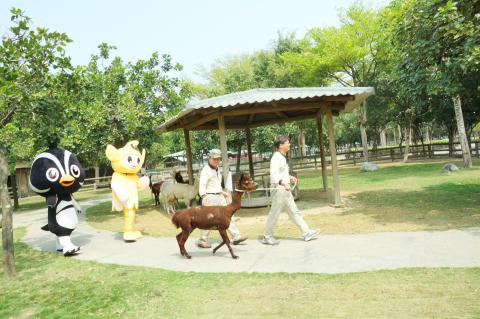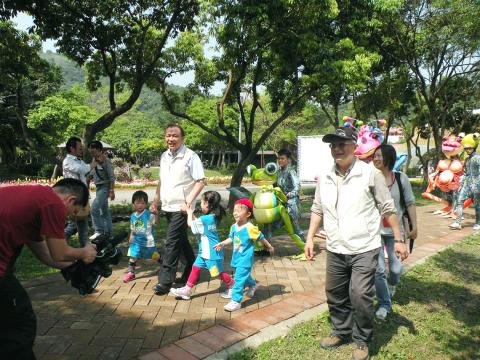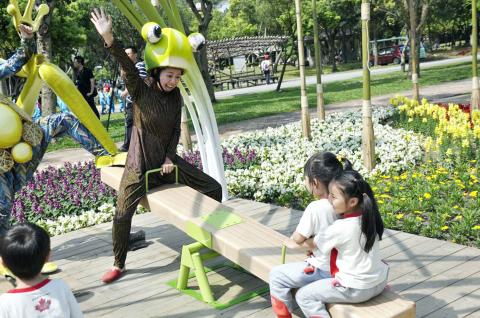The Yilan Green Expo has been taking place for over a decade and has become one of the most recognized environmental awareness activities in the country. This year, the event is back at the Wulaokeng Scenic Area (武荖坑風景區) where it will play host to a huge range of family activities for a total of 51 days. The expo, which opens tomorrow, combines tourism, food, entertainment and education in a single massive event that has greatly raised awareness of Yilan’s efforts to establish itself as a new Eden, an escape back to nature for residents of Taiwan’s overdeveloped west coast.
The 2013 Green Expo has adopted the theme of Return to the Forest, and promises visitors to Wulaokeng Scenic Area not just the beautiful scenery and warm welcome for which Yilan is already famous, but also a chance to reflect on issues such as bringing back a balance between the drive for production and the need to establish a quality of life. Finding a sustainable solution to preserving our modern lifestyles and conserving Taiwan’s increasingly threatened natural habitat tops the agenda, though you probably wouldn’t guess it from the host of fun activities, lucky draws, performances and DIY workshops to be found there.
Yilan County commissioner Lin Tsung-hsien (林聰賢) said that “natural agriculture, tourism, LOHAS lifestyle and healthy living, and experience and learning about nature” would be the keystones of this year’s event. Natural agriculture is an issue of growing importance given that Taiwan, according to a recent report based on the World Economic Forum’s Environmental Sustainability Index published by the Kuanshu Educational Foundation (觀樹教育基金會), is reported as being the heaviest user of chemical fertilizers and pesticides in the world. LOHAS is an acronym for Lifestyles of Health and Sustainability, a buzzword that has caught on in Taiwan through its linking of environmental issues with personal health. While it will take much more than Yilan’s Green Expo to change Taiwan’s agricultural habits, which for the large part continue to favor the use of chemicals to boost yields, Lin said that this year’s event, with the creation of an “organic lifestyle area,” would be an important milestone in pushing forward the policy of the “organic new Yilan.”

Photo Courtesy of the Lanyang Agricultural Development Foundation

Photo Courtesy of the Lanyang Agricultural Development Foundation

Photo Courtesy of the Lanyang Agricultural Development Foundation

Most heroes are remembered for the battles they fought. Taiwan’s Black Bat Squadron is remembered for flying into Chinese airspace 838 times between 1953 and 1967, and for the 148 men whose sacrifice bought the intelligence that kept Taiwan secure. Two-thirds of the squadron died carrying out missions most people wouldn’t learn about for another 40 years. The squadron lost 15 aircraft and 148 crew members over those 14 years, making it the deadliest unit in Taiwan’s military history by casualty rate. They flew at night, often at low altitudes, straight into some of the most heavily defended airspace in Asia.

Taiwan’s democracy is at risk. Be very alarmed. This is not a drill. The current constitutional crisis progressed slowly, then suddenly. Political tensions, partisan hostility and emotions are all running high right when cool heads and calm negotiation are most needed. Oxford defines brinkmanship as: “The art or practice of pursuing a dangerous policy to the limits of safety before stopping, especially in politics.” It says the term comes from a quote from a 1956 Cold War interview with then-American Secretary of State John Foster Dulles, when he said: ‘The ability to get to the verge without getting into the war is

Beijing’s ironic, abusive tantrums aimed at Japan since Japanese Prime Minister Sanae Takaichi publicly stated that a Taiwan contingency would be an existential crisis for Japan, have revealed for all the world to see that the People’s Republic of China (PRC) lusts after Okinawa. We all owe Takaichi a debt of thanks for getting the PRC to make that public. The PRC and its netizens, taking their cue from the Chinese Communist Party (CCP), are presenting Okinawa by mirroring the claims about Taiwan. Official PRC propaganda organs began to wax lyrical about Okinawa’s “unsettled status” beginning last month. A Global

Like much in the world today, theater has experienced major disruptions over the six years since COVID-19. The pandemic, the war in Ukraine and social media have created a new normal of geopolitical and information uncertainty, and the performing arts are not immune to these effects. “Ten years ago people wanted to come to the theater to engage with important issues, but now the Internet allows them to engage with those issues powerfully and immediately,” said Faith Tan, programming director of the Esplanade in Singapore, speaking last week in Japan. “One reaction to unpredictability has been a renewed emphasis on